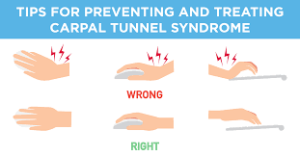Carpal Tunnel Syndrome: A Guide to Understanding the Wrist Pinch

Carpal tunnel syndrome (CTS) is a common condition affecting the hand and wrist. It arises from compression of the median nerve, a vital pathway for sensation and movement in your thumb, index, middle, and half of your ring finger.
Understanding the Carpal Tunnel:Imagine a tunnel at the base of your palm formed by bones and ligaments. This tunnel, called the carpal tunnel, houses the median nerve and tendons that flex your fingers. When swelling occurs in this area, it puts pressure on the median nerve, leading to the symptoms of CTS.
Causes of Carpal Tunnel Syndrome:
Several factors can contribute to CTS, including:
- Repetitive Motions: Activities that involve repeated flexing or gripping of the wrist, like typing, using tools, or playing certain sports, can irritate the tendons and cause swelling.
- Underlying Conditions: Obesity, pregnancy, diabetes, and rheumatoid arthritis can increase fluid retention and contribute to compression.
- Wrist Injuries: Fractures or sprains can damage the structure of the carpal tunnel, predisposing you to CTS.
Symptoms of Carpal Tunnel Syndrome:

The hallmark symptoms of CTS typically develop gradually and worsen at night:
- Numbness and Tingling: Often starting in the thumb, index, middle, and half of your ring finger, you might experience a pins-and-needles sensation.
- Pain: You might feel a dull ache or burning pain in the palm or wrist, radiating up the forearm.
- Weakness: Difficulty gripping objects or feeling clumsier in your hand can occur due to weakened muscles.
Diagnosis and Treatment of Carpal Tunnel Syndrome:
 A doctor can diagnose CTS through a physical examination and tests like Phalen’s maneuver or nerve conduction studies. Treatment options vary depending on the severity and aim to relieve pressure on the median nerve. Here’s a breakdown of potential approaches:
A doctor can diagnose CTS through a physical examination and tests like Phalen’s maneuver or nerve conduction studies. Treatment options vary depending on the severity and aim to relieve pressure on the median nerve. Here’s a breakdown of potential approaches:
- Rest and Splinting: Immobilizing the wrist with a splint at night can help reduce inflammation.
- Nonsteroidal Anti-inflammatory Drugs (NSAIDs): Over-the-counter pain relievers like ibuprofen can ease discomfort.
- Corticosteroid Injections: Injections directly into the carpal tunnel can significantly reduce inflammation.
- Physical Therapy: Exercises can strengthen hand and wrist muscles and improve flexibility.
- Surgery: In severe cases, a carpal tunnel release surgery might be necessary to create more space for the median nerve.
Preventing Carpal Tunnel Syndrome:

Here are some tips to minimize your risk of developing CTS:
- Maintain good posture: While working at a desk, ensure your wrists are straight and not bent at awkward angles.
- Take frequent breaks: Stretch your fingers and wrists regularly, especially during repetitive tasks.
- Strengthen hand and wrist muscles: Exercises can improve flexibility and reduce strain on the median nerve.
- Maintain a healthy weight: Excess weight can contribute to fluid retention and increase pressure in the carpal tunnel.
Remember: Early diagnosis and intervention are crucial for managing CTS effectively. If you experience persistent hand or wrist pain, numbness, or tingling, consult a doctor to determine the best course of treatment.
